story and photos by Kayte Deioma
 “If you build it, they will come” said a ghostly voice in the movie Field of Dreams. I can picture this same voice whispering to Frederick Braun when he came up with the idea to build the world’s biggest model train display. He convinced his more practical twin, Gerrit, that the project was feasible, and they set about putting together the funding and the team to make it happen. Now visitors are lining up to see the fantasy world they have created at Miniatur Wundurland.
“If you build it, they will come” said a ghostly voice in the movie Field of Dreams. I can picture this same voice whispering to Frederick Braun when he came up with the idea to build the world’s biggest model train display. He convinced his more practical twin, Gerrit, that the project was feasible, and they set about putting together the funding and the team to make it happen. Now visitors are lining up to see the fantasy world they have created at Miniatur Wundurland.
 Since 2001, this ever-expanding project has occupied a warehouse in the Speicherstadt district in Hamburg, Germany. Starting with 975 square feet of tableaus representing areas of southern Germany and the Austrian Alps, the exhibit has more than tripled in size to over 3700 square feet with the addition of Hamburg, Scandinavia, and America, and the latest creation, a multi-story model of Switzerland.
Since 2001, this ever-expanding project has occupied a warehouse in the Speicherstadt district in Hamburg, Germany. Starting with 975 square feet of tableaus representing areas of southern Germany and the Austrian Alps, the exhibit has more than tripled in size to over 3700 square feet with the addition of Hamburg, Scandinavia, and America, and the latest creation, a multi-story model of Switzerland.
The seven geographic areas host over 800 trains, of which 90 to 100 are moving at any given time. The longest regularly running train is about 45 feet. In the control room, 40 computers operate the trains, 5,500 cars and trucks, 900 traffic signals, and 300,000 lights from car turn signals to the Vegas Strip, carnival lights, fire flames and house lights that come on one at a time as the sun goes down across two continents.
 Loving detail has gone into recreating Hamburg, from the Town Hall to Landungsbrucken and St. Michael’s Church to the red light district of the Reeperbahn, to the thousands of mini fans packing the AOL Arena for an HSV soccer game. Ships and tour boats navigate real water in the harbor, while dozens of trains make their way through the Hamburg Main Train Station and subways stop at Baumwall, where a crowd has gathered for a techno music parade. Elephants cavort in the Hagenbeck Zoo; fire crews respond to a building fire; bikers race across the Kohlbrand Bridge; trucks load their wares in the Speicherstadt, tourists line up to get into the Dungeon, and daily life goes on in suburbs. Hollywood’s best model makers couldn’t have done any better.
Loving detail has gone into recreating Hamburg, from the Town Hall to Landungsbrucken and St. Michael’s Church to the red light district of the Reeperbahn, to the thousands of mini fans packing the AOL Arena for an HSV soccer game. Ships and tour boats navigate real water in the harbor, while dozens of trains make their way through the Hamburg Main Train Station and subways stop at Baumwall, where a crowd has gathered for a techno music parade. Elephants cavort in the Hagenbeck Zoo; fire crews respond to a building fire; bikers race across the Kohlbrand Bridge; trucks load their wares in the Speicherstadt, tourists line up to get into the Dungeon, and daily life goes on in suburbs. Hollywood’s best model makers couldn’t have done any better.
 America is about 1/3 the size of Hamburg. Las Vegas is well represented with landmark buildings like the MGM Grand, Luxor and Paris Las Vegas that light up when night falls, which is every 15 minutes at Miniatur Wunderland. In addition to the many cars and trucks moving through the streets and the monorail on the Strip, you get a view of the passenger and cargo trains making their way across the desert and through the Vegas railroad station, that most real life visitors would never see.
America is about 1/3 the size of Hamburg. Las Vegas is well represented with landmark buildings like the MGM Grand, Luxor and Paris Las Vegas that light up when night falls, which is every 15 minutes at Miniatur Wunderland. In addition to the many cars and trucks moving through the streets and the monorail on the Strip, you get a view of the passenger and cargo trains making their way across the desert and through the Vegas railroad station, that most real life visitors would never see.
 Adjacent to Las Vegas, Mount Rushmore and the Grand Canyon are in close proximity to each other with mining towns, Indian pueblos and Area 51 in between, all connected by trestle railroad bridges and a freeway system full of semis and tanker trucks. Amtrak delivers passengers to nearby Miami Beach, with its Art Deco architecture and palm trees. Cape Canaveral, the Everglades and Key West fill in the rest of Florida.
Adjacent to Las Vegas, Mount Rushmore and the Grand Canyon are in close proximity to each other with mining towns, Indian pueblos and Area 51 in between, all connected by trestle railroad bridges and a freeway system full of semis and tanker trucks. Amtrak delivers passengers to nearby Miami Beach, with its Art Deco architecture and palm trees. Cape Canaveral, the Everglades and Key West fill in the rest of Florida.
 Switzerland, which opened in November 2007 is the first multi-level exhibit, covering over 800 square feet. The Matterhorn rises from the third to the fourth floor of the building through an opening in the ceiling. You can follow the trains up the mountain via a stairway or look down on the scene from the railing above. Other things going on in the Swiss scene include a renaissance fair with knights competing in a joust near the foot of Castello di Montebello, workers making chocolate bars at the Lindt & Sprungli factory, and 20,000 fans camped out at a DJ Bobo concert, complete with requisite port-a-potties.
Switzerland, which opened in November 2007 is the first multi-level exhibit, covering over 800 square feet. The Matterhorn rises from the third to the fourth floor of the building through an opening in the ceiling. You can follow the trains up the mountain via a stairway or look down on the scene from the railing above. Other things going on in the Swiss scene include a renaissance fair with knights competing in a joust near the foot of Castello di Montebello, workers making chocolate bars at the Lindt & Sprungli factory, and 20,000 fans camped out at a DJ Bobo concert, complete with requisite port-a-potties.
 There is so much incredible detail to the models at Miniatur Wunderland that you could spend all day and not see everything. If you take just long enough to see the daylight and nighttime version of each set, you need a minimum of two hours, even for a superficial view. If you have kids along, you should allow plenty of time for them to push
There is so much incredible detail to the models at Miniatur Wunderland that you could spend all day and not see everything. If you take just long enough to see the daylight and nighttime version of each set, you need a minimum of two hours, even for a superficial view. If you have kids along, you should allow plenty of time for them to push  Behind the Scenes Tours let you see the inner workings of the systems and go behind the models to see where the trains go when they enter the tunnels. The tour goes through some pretty tight spaces, so size restrictions apply.
Behind the Scenes Tours let you see the inner workings of the systems and go behind the models to see where the trains go when they enter the tunnels. The tour goes through some pretty tight spaces, so size restrictions apply.
There is a restaurant on site in case you need a refreshment break, and the gift shop has everything imaginable to start your own model project at home.
Miniatur Wunderland has a great website with extensive photos, videos, facts and figures, including weekly updates (in German) on new construction. There is an English language version of the site at www.miniatur-wunderland.com. Check the video section for train cam videos through Miniatur Wunderland.
From the German version of the website, I recommend the video showing The Construction of Switzerland in 10 Minutes.
Buy your tickets online in advance to avoid a long wait to get in, or check the section on Waiting Times on the website so see the estimated wait times for a given day.
Miniatur Wunderland Hamburg
Kehrwieder 2-4,
Block D 20457 Hamburg – Speicherstadt
(49) (0) (40) 300 6800
www.miniatur-wunderland.com

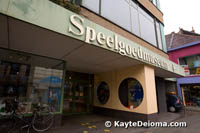
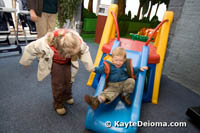
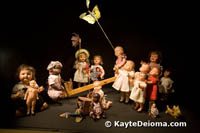
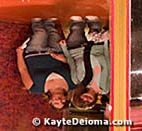
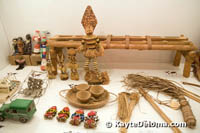
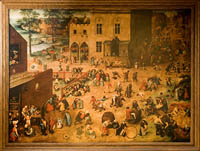
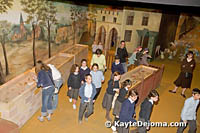
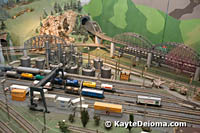
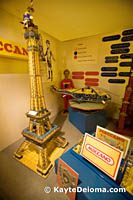
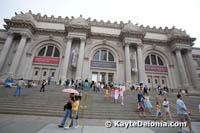 Since I was in New York this time with my sister and her kids, I decided that it was more important for the kids to get a taste of great art than to worry about not having time to see the whole thing, and thereby miss everything. We didn’t expect the kids to have the patience to stay in a museum more than a couple hours anyway.
Since I was in New York this time with my sister and her kids, I decided that it was more important for the kids to get a taste of great art than to worry about not having time to see the whole thing, and thereby miss everything. We didn’t expect the kids to have the patience to stay in a museum more than a couple hours anyway.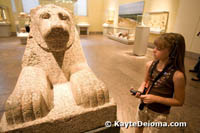 We rented the audio tour headsets, which I don’t usually do on my own, but it turned out to be great for the kids. It was easier for the younger ones than reading the information panels. As we moved through the colorful sarcophagi, carved limestone monuments and painted hieroglyphics, they really enjoyed punching in the numbers and having control over which descriptions they heard. There wasn’t a child-friendly version of the tour like there is some places, but they seemed to do just fine.
We rented the audio tour headsets, which I don’t usually do on my own, but it turned out to be great for the kids. It was easier for the younger ones than reading the information panels. As we moved through the colorful sarcophagi, carved limestone monuments and painted hieroglyphics, they really enjoyed punching in the numbers and having control over which descriptions they heard. There wasn’t a child-friendly version of the tour like there is some places, but they seemed to do just fine.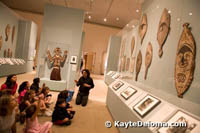 We met the rest of the families downstairs in the Uris Center for Education. After a brief introduction, our guide, Amir Parsa, took us back upstairs to the Arts of Africa, Oceania and the Americas. We all settled on the floor in front of a glass case lined with carved wooden masks from Mali. After a brief Q and A about the use of masks around the world, we learned more about these Dogon Masks, used in mourning dances several years after the person died.
We met the rest of the families downstairs in the Uris Center for Education. After a brief introduction, our guide, Amir Parsa, took us back upstairs to the Arts of Africa, Oceania and the Americas. We all settled on the floor in front of a glass case lined with carved wooden masks from Mali. After a brief Q and A about the use of masks around the world, we learned more about these Dogon Masks, used in mourning dances several years after the person died.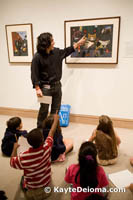 We moved around the corner to Papua New Guinea to study more masks and spirit boards from the temporary exhibit “Coaxing the Spirits to Dance: Art of the Papuan Gulf.” After studying the intricately carved and painted spirit boards and learning how art and culture go hand in hand, children and parents were given paper and pencils to copy their favorite board designs, or create their own.
We moved around the corner to Papua New Guinea to study more masks and spirit boards from the temporary exhibit “Coaxing the Spirits to Dance: Art of the Papuan Gulf.” After studying the intricately carved and painted spirit boards and learning how art and culture go hand in hand, children and parents were given paper and pencils to copy their favorite board designs, or create their own.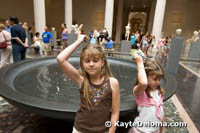 After our hour-long journey into art appreciation, we planned our exit route to take in the new Greek and Roman sculpture exhibit in the sky-lit Leon Levy and Shelby White Court. The atrium, populated with Roman statues from the first century BC to the third century AD, was a great preview for Derick, who would soon be setting off on an excursion to Italy.
After our hour-long journey into art appreciation, we planned our exit route to take in the new Greek and Roman sculpture exhibit in the sky-lit Leon Levy and Shelby White Court. The atrium, populated with Roman statues from the first century BC to the third century AD, was a great preview for Derick, who would soon be setting off on an excursion to Italy.